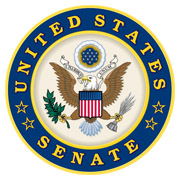 Washington, D.C. – U.S. Senators Marsha Blackburn (R-Tenn.) and Roger Wicker (R-Miss.), along with 40 of their colleagues, sent a letter to the heads of the Office of Personnel Management (OPM), the General Services Administration (GSA), and the Office of Management and Budget (OMB) to request immediate action to transition federal workers back to in-person operations.
Washington, D.C. – U.S. Senators Marsha Blackburn (R-Tenn.) and Roger Wicker (R-Miss.), along with 40 of their colleagues, sent a letter to the heads of the Office of Personnel Management (OPM), the General Services Administration (GSA), and the Office of Management and Budget (OMB) to request immediate action to transition federal workers back to in-person operations.
In the letter, the senators cite the “widespread lack of responsiveness and accessibility across the federal government on account of current agency work plans,” which have kept workers out of the office and have contributed to huge delays for government services.
The letter follows months of delays from the Joe Biden Administration on implementing plans for agencies to return their workforce to the office and to address the mounting backlog of cases that arose while workers were working from home.
The senators cite several examples of the impact this extended absence has had on government services:
- Department of Veterans Affairs– As of August 30th, 2021, there were almost 182,000 claims at the Department of Veterans Affairs that were backlogged because of a pause of in-person Compensation and Pension examinations last year.
- Internal Revenue Service– As of October 2nd, 2021, the IRS had 6.8 million unprocessed individual 2020 tax year returns.
- State Department– The wait time to get a new passport is now 12 to 18 weeks.
- Social Security Administration– Social Security offices throughout the country have been closed except for those beneficiaries who make an appointment and are deemed to be in “dire need.” Social Security recipients have been forced to use unreliable mail services to send personal identifying information or paperwork to local field offices as most offices will not accept these documents in person.
On June 10th, 2021, GSA, OMB, and OPM issued a memo regarding the return of federal employees and contractors to physical workplaces. The deadline to submit their plans was July 19th, 2021. However, given President Biden’s new vaccine mandate and the spread of the Delta variant, many agencies have had to produce new plans, which are currently still unavailable to the general public and to Congress despite ongoing requests.
As the senators write, only one agency out of 20 that were recently contacted was able to provide a plan for its employees.
“We understand the unique challenges that COVID-19 has presented, but Americans continue to face unprecedented delays in accessing their federal government. This is unacceptable,” the senators wrote.
The senators also expressed their view that the federal government should consider the costs to taxpayers of paying for office space that is not used, saying it is a “drain on taxpayers who are ultimately paying the price for empty offices.”
“It is now time to bring back our federal workers and deliver the service that the American people have been promised and expect of their government,” the senators concluded.
In addition to Blackburn and Wicker, the letter is signed by John Barrasso (R-Wyo.), Roy Blunt (R-Mo.), John Boozman (R-Ark.), Mike Braun (R-Ind.), Shelley Moore Capito (R-W.Va.), Bill Cassidy (R-La.), Susan Collins (R-Maine), John Cornyn (R-Texas), Kevin Cramer (R-N.D.), Mike Crapo (R-Idaho), Ted Cruz (R-Texas), Joni Ernst (R-Iowa), Lindsey Graham (R-S.C.), Chuck Grassley (R-Iowa), Bill Hagerty (R-Tenn.), Josh Hawley (R-Mo.), John Hoeven (R-N.D.), Cindy Hyde-Smith (R-Miss.), James Inhofe (R-Okla.), John Kennedy (R-La.), James Lankford (R-Okla.), Mike Lee (R-Utah), Cynthia Lummis (R-Wyo.), Roger Marshall (R-Kan.), Jerry Moran (R-Kan.), Rand Paul (R-Ky.), Rob Portman (R-Ohio), James Risch (R-Idaho), Mitt Romney (R-Utah), Marco Rubio (R-Fla.), Ben Sasse (R-Neb.), Dan Sullivan (R-Alaska), John Thune (R-S.D.), Thom Tillis (R-N.C.), Patrick Toomey (R-Pa.), Todd Young (R-Ind.), Steve Daines (R-Mont.), Deb Fischer (R-Neb.), Rick Scott (R-Fla.), and Richard Burr (R-N.C.).
See the full letter here or below:
Dear Director Ahuja, Acting Director Young, and Administrator Carnahan:
We wish to express our concern about the widespread lack of responsiveness and accessibility across the federal government on account of current agency work plans. We request immediate action to transition federal workers back to in-person operations.
The pandemic has affected all Americans who participate in the workforce. Every working individual was forced to adapt quickly during the onset of the pandemic to do their part to reduce the spread of the virus and protect capacity in our health care systems. Fortunately, with the widespread availability of vaccines, testing, and other safety measures, new COVID-19 cases, deaths, and hospitalizations are all now steadily declining. The Centers for Disease Control and Prevention predicts deaths and hospitalizations will continue to fall.[1]
Members of Congress from both parties have raised concerns about backlogs and productivity issues across agencies. For example, since the beginning of the pandemic, Social Security offices throughout the country have been closed except for those beneficiaries who make an appointment and are deemed to be in “dire need.” Furthermore, Social Security recipients have been forced to use unreliable mail services to send personal identifying information or paperwork to local field offices as most offices will not accept these documents in person.
As of August 30th, 2021, there were almost 182,000 claims at the Department of Veterans Affairs that were backlogged because of a pause of in-person Compensation and Pension examinations last year. As of October 2, 2021, the IRS had 6.8 million unprocessed individual 2020 tax year returns.[2] The wait time to get a new passport is now 12 to 18 weeks.[3]
As you know, on June 10th, 2021, the Joe Biden Administration, in conjunction with the Office of Personnel Management (OPM), the Office of Management and Budget (OMB), and the General Services Administration (GSA), released OMB Memorandum M-21-25 outlining the procedures for the safe return of federal workers and contractors to their workplace. This memorandum required the agencies to submit their reentry plan no later than July 19, 2021. Additionally, Memorandum M-21-25 states that agencies should be “seeking and considering data and information regarding the impact of personnel policies and procedures on employee engagement, mission delivery and outcomes.”[4]
On August 6th, 2021, Senate Congressional offices were invited to join a call with OPM, OMB, and GSA on this issue. Unfortunately, the majority of staff questions were left unanswered, including whether or not every agency had complied with the July 19 deadline set by the Memorandum M-21-25. On September 9th, 2021, President Biden issued the Executive Orders on Requiring Coronavirus Disease 2019 Vaccination for Federal Employees (EO 14043) and Ensuring Adequate COVID Safety Protocols for Federal Contractors (EO 14042). The latter order requires all federal employees and federal contractors be vaccinated against COVID-19 by December 8th, 2021.
We understand the unique challenges that COVID-19 has presented, but Americans continue to face unprecedented delays in accessing their federal government. This is unacceptable, particularly since agency heads have had the ability to address productivity since June 2021, when the Biden Administration lifted its 25 percent cap on the number of federal employees allowed to report to worksites.
Additionally, if agencies are pivoting to more permanent off-site work, there are a number of costs that must be considered. For example, field and operational office spaces have maintained their leases during the period that a regular in-person presence has lapsed and employees continue teleworking. This office space footprint is a drain on taxpayers who are ultimately paying the price for empty offices.
In our efforts to contact more than 20 federal agencies about their plans to return to work, or even a general outline, only one agency could point to an outline of their reentry plans on their website. Others have either cited ongoing negotiations with their unions or said they had no plan to share with our offices at this time. This lack of transparency is a disservice to the taxpayers that these agencies were created to support and protect.
We, therefore, request a response to the following questions by the appropriate agencies no later than November 11th, 2021.
- How many and which agencies have submitted a reentry plan as of October 27th, 2021?
- How many and which agencies have submitted a post-reentry plan as of October 27th, 2021?
- Which agencies have submitted organization-wide data collecting on remote work productivity in order to inform decision-making regarding reentry and post-reentry work?
- Which agencies were staffed at below 25 percent in-person operations, on average, between March 1st, 2020, and January 24th, 2021?
- How many buildings are owned or leased by the General Services Administration? Of those buildings, which and how many were staffed at below 25 percent in-person operations, on average, between March 1st, 2020 and January 24th, 2021?
- Have OMB, OPM, GSA, and any other agencies involved in federal workforce guidance postponed the request for reentry plans because of vaccine hesitancy among employees?
- Do OMB, OPM, GSA, and any other agencies involved in federal workforce guidance have immediate plans to issue additional guidance or deadlines to have the workforce return on site to pre-pandemic levels?
- What measures do agencies have in place to protect individuals’ personal identifying information while employees work remotely?
- How many positions have been shifted to full-time remote optional since January 2021?
- How many employees have requested to return to in-person work but been denied due to current agency operating status?
We appreciate the work of America’s federal workforce and maintain that the health and safety of those employees and their families are a priority. However, with the resources available to each agency and every federal employee, it is now time to bring back our federal workers and deliver the service that the American people have been promised and expect of their government.
[1] COVID-19 Forecasts: Cases | CDC
[2] https://www.forbes.com/sites/ashleaebeling/2021/10/10/millions-still-due-2020-tax-refunds-as-october-15-extension-deadline-nears/?sh=2befb6828b58
[3] https://www.state.gov/briefing-with-deputy-assistant-secretary-for-passport-services-rachel-arndt-bureau-of-consular-affairs-on-the-state-departments-passport-services/
[4] https://www.whitehouse.gov/wp-content/uploads/2021/06/M-21-25.pdf



